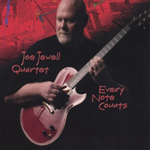Home » Jazz Articles » Live Review » The Django Reinhardt New York Festival at Birdland, Nove...
The Django Reinhardt New York Festival at Birdland, November 11, 2006
The freight train effect of this 'Le Jazz Hot' style cannot be overstated.
Birdland
Saturday, November 11, 2006
If music can ever be said to bring sheer, unadulterated, unfettered joy, it did so on this night and, I was told, on every night since the preceding Tuesday, when the Birdland DjangoFest started. There were French exchanges between the crowd, and the musicians and everyone there wanted to bathe in the spirit of Django.
The air of anticipation that precedes shows of this kind was exceptionally intense, and the club was almost full an hour before show time, which is quite unusual. The audience was there not to hear music in the inimitable style of Django, but music inhabited by the spirit of Django, played by musicians who really know him, at least musically.
The main musicians were the quartet of Dorado Schmitt, who played both lead guitar and violin and sang; Samson Schmitt, his son, on rhythm guitar; Ludovic Beier on accordion and melodica; and Alexandre Cavaliere on violin. This central group was augmented at different times by guitarist Kruno Spisick and pianist Ray Kennedy.
The show started with the duo of Samson Schmitt and Ludovic Beier. Most of Samson's playing was on rhythm guitar when Dorado was on stage, but here he had a chance to let loose and show his own formidable chops and musicianship—along with a very warm smile. Beier played accordion like it was any other keyboard instrument, roaming all over his fingerboard and matching Samson's pyrotechnics in a demonstration of a very close musical simpatico between the two musicians.
Cavaliere came out next, very thin and very young, but immediately swept the crowd up in his energy, as he barely stayed seated in his chair. The spirit of Grappelli and Reinhardt were in the air from the moment bow touched string. When the patriarch Dorado came on stage, it was clear we were in the presence of a master musician for whom technique is secondary, and he ran the show as soon as he sat down. Several of his beautiful French/ gypsy inflected compositions were played, and he caressed his guitar in a manner that said the technique was there but was not needed.
Dorado then picked up a violin and proceeded to give Cavaliere a run for his money in a set piece of dueling violins that nevertheless went beyond who could play faster. The comraderie was quite evident, and all the musicians were smiling and enjoying themselves. Next, Spisick, who is from Philadelphia, came out and played well, though the difference in maturity, if not chops, was quite clear. Ray Kennedy, a local swing player, then came on and led the band through a few swing favorites, including "Honeysuckle Rose" and "Avalon."
The freight train effect of this "Le Jazz Hot" style cannot be overstated. With no drummer, and just Brian Torff on double bass, the chugging of this fast 4/4 swing, played 1-2-3-4 with very little accent on beats 2 and 4, is relentless, and eventually hypnotizing. Yes, there was some showing off, some throw-away, amazingly fast arpeggios plus that "Django-picked" sliding single-string chromatic scale. However, the show mostly evidenced what I hear on Django's recordings—incredible technique fused with a musical spirit that inhabits every note.
Cavaliere's energy and charisma, Beier's warmth and understated musicianship, and Samson Schmitt's modesty and humanity all fed into and shone on Dorado Schmitt's centered presence and extreme mastery.
In all honesty, this group could have played almost anything and elicited whoops and cheers, even when ending the show with the clichéd song of Django's "Minor Swing" that segued into a supersonic "Dark Eyes." However, spirit and musicianship triumphed over showmanship, and the buzz yielded to a spell that lingered for hours after the show ended.
Tags
PREVIOUS / NEXT
Support All About Jazz
 All About Jazz has been a pillar of jazz since 1995, championing it as an art form and, more importantly, supporting the musicians who make it. Our enduring commitment has made "AAJ" one of the most culturally important websites of its kind, read by hundreds of thousands of fans, musicians and industry figures every month.
All About Jazz has been a pillar of jazz since 1995, championing it as an art form and, more importantly, supporting the musicians who make it. Our enduring commitment has made "AAJ" one of the most culturally important websites of its kind, read by hundreds of thousands of fans, musicians and industry figures every month.























